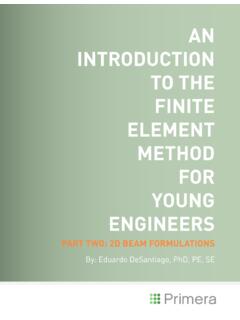Transcription of AN INTRODUCTION TO THE FINITE ELEMENT METHOD FOR …
1 ANINTRODUCTIONTO THEFINITE ELEMENTMETHODFORYOUNGENGINEERSBy: Eduardo DeSantiago, PhD, PE, SE Table of Contents SECTION I INTRODUCTION .. 2 SECTION II 1- D EXAMPLE .. 2 SECTION III DISCUSSION .. 13 SECTION IV REFERENCES .. 14 Primera An INTRODUCTION to the FINITE ELEMENT METHOD for Young Engineers 1 I. INTRODUCTION The FINITE ELEMENT METHOD (FEM) has become an indispensable modern tool for mechanical and structural engineers. It is difficult to imagine an engineering firm that doesn t have access to one of the many available FEM commercial codes. Modern commercial FEM codes have become very sophisticated and allow for the development of complex 3-D models with relative ease.
2 Unfortunately, the ease of use of these sophisticated codes may lead the unsuspecting user to assume a higher level of understanding of the complex theoretical underpinnings of the FINITE ELEMENT METHOD than actually exists. Leading to this situation is the fact that many engineers graduate without ever taking a course on FEM theory, yet make use of the METHOD on a daily basis. Needless to say this situation is fraught with danger. This article is the first in a series that will attempt to introduce some of the rich and complex theory that forms the foundation of the FINITE ELEMENT METHOD of analysis in the hopes that it will stir an interest in the reader to develop a more fundamental understanding of the METHOD if it doesn t already exist.
3 The ideas to be presented have been developed through several years of graduate study, research, and teaching in FINITE ELEMENT analysis by the author. Many of the topics to be covered come directly from graduate courses taught on FEM at the Illinois Institute of Technology. II. 1-D Example To help introduce basic mathematical concepts we will limit discussion to a one-dimensional problem involving the axial deformation of a prismatic bar. Consider the case of a bar with a constant axial stiffness EA that is loaded by an axially distributed load given by ( ) = 0 2 where p0 is a constant, L is the total length of the bar, and x is the variable distance along the bar.
4 The bar is fixed between two rigid supports such that the axial displacement of the bar is prevented at both ends. Primera An INTRODUCTION to the FINITE ELEMENT METHOD for Young Engineers 2 If we denote the axial displacement of the bar as u(x); then to satisfy equilibrium at every single point along the length of the bar, the following equation must hold: 2 + ( )=0 The exact solution for the above equation can be shown to be: Now one can use the above 1-D example with a known exact solution to compare and contrast common numerical methods including the FINITE ELEMENT METHOD used to find approximate solutions to the problem.
5 A. FINITE Difference METHOD In the FINITE difference METHOD , approximations to the second order derivative are used to obtain a numerical solution to the differential equation of equilibrium. In general for any function f(x) defined over a FINITE range one can split the range into n equal intervals each of length h. Thus: Primera An INTRODUCTION to the FINITE ELEMENT METHOD for Young Engineers 3 In the forward difference METHOD the first and second derivatives of the function at xi are approximated using information at xi+1 and xi+2, thus the term forward. These derivatives are given by: ( ) +1 2 ( ) +2 2 +1+ 2 In the backward difference METHOD the first and second derivatives of the function at xi are approximated using information at xi-1 and xi-2, thus the term backward.
6 These derivatives are given by: ( ) 1 2 ( ) 2 1+ 2 2 In the central difference METHOD the first and second derivatives of the function at xi are approximated using information at both xi-1 and xi+1, thus the term central. These derivatives are given by: ( ) +1 12 2 ( ) +1 2 + 1 2 Before taking a look at how these methods behave for the model 1-D problem it is important to note that the complexity of the FINITE difference METHOD approximations increases as the order of the derivatives increases. Our relatively simple problem only has second order derivatives, but for many physical problems the order of the highest derivative is greater than two.
7 The Bernouilli-Euler Beam theory, for example, leads to a differential equation of equilibrium that contains a fourth order derivative. For a fourth order derivative, the difference METHOD would lead to approximations for the fourth order derivative that would contain five terms in the numerator. Primera An INTRODUCTION to the FINITE ELEMENT METHOD for Young Engineers 4 Using the central difference METHOD to obtain an approximate solution to our 1-D bar problem leads to n- 1 simultaneous equations of the following form: Recasting the equations in matrix form leads to a discrete approximation to the problem with the typical format of Kd=F, where K is termed the stiffness matrix, d the displacement vector, and F the forcing vector, Before continuing on, it is important to note the structure of the stiffness matrix above.
8 The only nonzero entries are along the three columns centered on the diagonal. This particular matrix is called a tri-diagonal matrix. The structure of the matrix results directly from the local nature of the approximations used. For example, the value of u at xi is only directly linked to the values at xi-1 and xi+1, its immediate neighbors. This point is introduced because the nature of the structure of the matrix can be exploited to decrease the memory storage required and to improve the speed at which the solutions to the simultaneous equations can be obtained. This is, in fact, the idea behind bandwidth solvers, skyline or profile solvers, and today s state-of-the-art sparse solvers.
9 The plot on the following page shows a comparison of the approximate solution to the axial displacement for the cases where n=3, 6, and 12: Primera An INTRODUCTION to the FINITE ELEMENT METHOD for Young Engineers 5 If one defines the error in the solution as follows: Then the plot of the error vs h for the forward, backward, and central difference methods are given below. Recall that h is the length of the intervals the problem is broken up into for the approximations used. As one increases the number of intervals the value of h decreases and, as can be seen from the plots below, the error in the approximation decreases.
10 In FINITE ELEMENT formulations, h is known as the mesh size. The backward and forward difference METHOD are first order accurate in that the error is proportional to h. The central difference METHOD on the other hand is quadratic in that the error is proportional to h2. Thus, as h becomes small, h2 decreases at a quadratic rate: Primera An INTRODUCTION to the FINITE ELEMENT METHOD for Young Engineers 6 B. Rayleigh-Ritz METHOD The Rayleigh-Ritz METHOD is another approximation that can be used to solve the model 1-D bar problem. However, before employing the METHOD the equation of equilibrium must be recast into the variational form.











